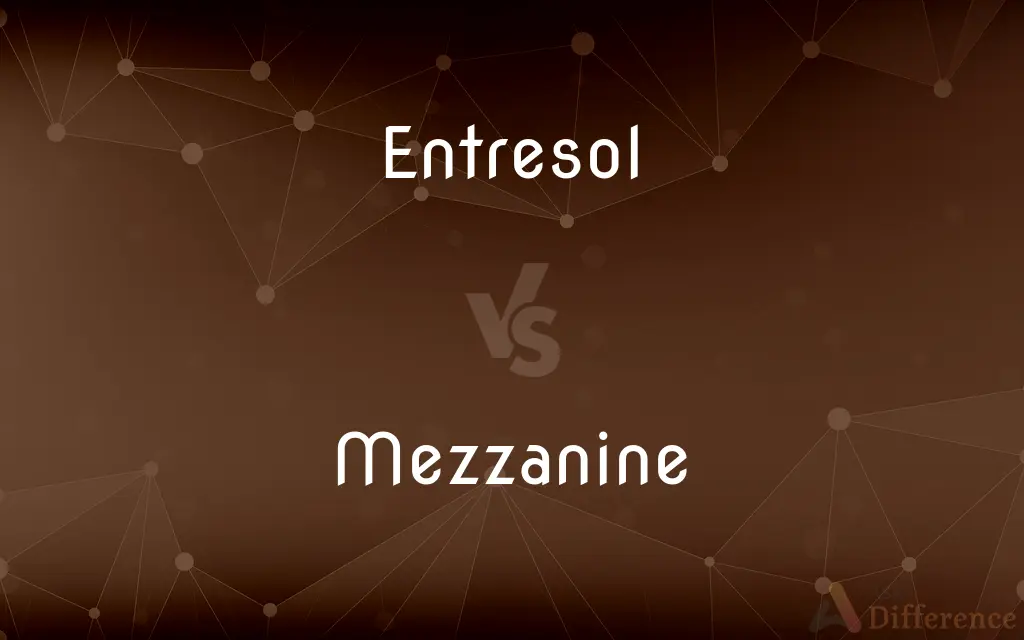Entresol vs. Mezzanine — What's the Difference?
By Tayyaba Rehman & Maham Liaqat — Updated on April 5, 2024
An entresol is a low-ceiling intermediate floor inserted between main floors of a building, often hidden or not immediately apparent, while a mezzanine is a partial floor in a building, open to the floor below, typically used for additional space.

Difference Between Entresol and Mezzanine
Table of Contents
ADVERTISEMENT
Key Differences
Entresols, derived from French meaning 'intermediate floor', are usually constructed within high-ceilinged buildings to utilize space efficiently without altering the building's exterior appearance. These floors can serve various functions, such as storage or office spaces, but they tend to have limited accessibility and visibility, distinguishing them from more prominent architectural features. In contrast, mezzanines are designed to be integral parts of a building's interior aesthetic and functionality. They are often used in commercial, public, or residential buildings to create an open, airy environment. Mezzanines provide additional space for lounges, dining areas, or offices, and are typically accessible by stairs or elevators, making them more functional for frequent use.
While both entresols and mezzanines optimize space in buildings with high ceilings, entresols are more about discreetly adding utility or value without significant changes to the building's original design or structure. Mezzanines, however, are planned and built to enhance the architectural design, offering both practical space solutions and aesthetic appeal. They are often constructed with materials and designs that complement the main interior, and their open aspect can transform the look and feel of a space, making it appear larger and more inviting.
The choice between an entresol and a mezzanine often depends on the specific needs of the building or space, including the desired function, accessibility, and impact on the building’s design. Entresols are suitable for adding hidden or private spaces, while mezzanines are better suited for adding visible, accessible, and functional areas that enhance a building's interior space.
Entresols might be found in older buildings where extra space was needed without a complete renovation, whereas mezzanines are often incorporated into the design of new buildings or major renovations to add an element of modernity and openness. Furthermore, regulatory and safety standards may also influence the decision, as mezzanines, being more prominent and accessible, require careful consideration of building codes, particularly regarding safety exits and accessibility.
While both entresols and mezzanines serve to utilize vertical space within buildings, their design, visibility, and functionality distinguish them. Entresols are more about adding space efficiently and discreetly, while mezzanines are about creating a visible, accessible, and aesthetically pleasing addition to the building’s interior.
ADVERTISEMENT
Comparison Chart
Definition
An intermediate floor inserted between the main floors of a building, often with low ceiling and limited visibility.
A partial floor in a building, usually open to the floor below, designed as an integral part of the building’s layout.
Purpose
Adds extra space discreetly, often used for storage or additional offices.
Enhances space and aesthetic appeal; used for lounges, additional seating, or special purposes.
Visibility
Limited, not designed to be a prominent feature.
Open and visible, contributing to the building's aesthetic.
Accessibility
Limited accessibility, not typically designed for frequent public use.
Easily accessible, often includes stairs or elevators for public or frequent use.
Design Impact
Minimal impact on building's original design or exterior appearance.
Significant impact on interior design, promoting openness and modernity.
Compare with Definitions
Entresol
A low-ceilinged intermediate floor between main floors.
The entresol in the old library houses rare book collections.
Mezzanine
A partial, open floor within a larger building space.
The bookstore features a mezzanine for reading and events.
Entresol
Offers privacy and additional utility space.
The office building utilizes an entresol for extra storage.
Mezzanine
Enhances aesthetics and functional space.
The new hotel lobby's mezzanine adds space and elegance.
Entresol
Designed for efficient space use without altering exterior.
The museum added an entresol to store archives discreetly.
Mezzanine
Typically accessible, integrated into the building design.
The mezzanine level in the mall includes cafes and seating areas.
Entresol
Limited accessibility, used for specific needs.
The entresol in the warehouse is accessed only by staff for inventory.
Mezzanine
A visible, integral part of interior design.
The art gallery's mezzanine offers a unique view of the exhibits below.
Entresol
Not immediately apparent, maintaining building aesthetics.
The entresol in the theatre provides additional dressing rooms.
Mezzanine
Subject to safety and building regulations.
The conference center's mezzanine has emergency exits and accessible features.
Entresol
A mezzanine, especially one just above the ground floor of a building.
Mezzanine
A mezzanine (; or in Italian, a mezzanino) is, strictly speaking, an intermediate floor in a building which is partly open to the double-height ceilinged floor below, or which does not extend over the whole floorspace of the building. However, the term is often used loosely for the floor above the ground floor, especially where a very high original ground floor has been split horizontally into two floors.
Entresol
A mezzanine; an intermediate floor in a building, typically resembling a balcony; most often, the floor immediately above the ground floor and below a higher floor.
Mezzanine
A partial story between two main stories of a building.
Entresol
A low story between two higher ones, usually between the ground floor and the first story; mezzanine.
Mezzanine
The lowest balcony in a theater or the first few rows of that balcony.
Mezzanine
Of or relating to securities granting a claim on interest or assets that is subordinate to that of secured and senior debt but above that of equity.
Mezzanine
(architectural element)
Mezzanine
An intermediate floor or storey in between the main floors of a building; specifically, one that is directly above the ground floor which does not extend over the whole floorspace of the building, and so resembles a large balcony overlooking the ground floor; an entresol.
On our way to the top floor, we stopped at the mezzanine.
Mezzanine
(by extension) An apartment, room, etc., on such an intermediate floor.
Mezzanine
The lowest balcony in an auditorium, cinema, theatre, etc.; the dress circle.
Mezzanine
(obsolete)
Mezzanine
A floor under the stage, from which contrivances such as traps are worked.
Mezzanine
Characteristic of or relating to high-interest loans which have no collateral, and are regarded as intermediate in nature, ranking above equity but below secured loans.
Mezzanine
(engineering) Fulfilling an intermediate or secondary function.
To make interconnections easier, we added a mezzanine PCB.
Mezzanine
(transitive) To fit (a building or other place) with a mezzanine floor.
Mezzanine
Same as Entresol.
Mezzanine
A flooring laid over a floor to bring it up to some height or level.
Mezzanine
A floor under the stage, from which various contrivances, as traps, are worked.
Mezzanine
The lowest balcony in a theater, or the forward part of the first balcony.
Mezzanine
First or lowest balcony
Mezzanine
Intermediate floor just above the ground floor
Common Curiosities
How does a mezzanine differ from a regular floor?
A mezzanine is a partial floor, open to the floor below, not extending over the full floor area, making it different from a full story.
Can a mezzanine be added to any building?
Adding a mezzanine depends on the building's ceiling height, structural capacity, and compliance with building codes.
Is an entresol considered a separate floor in a building?
Legally or in terms of building codes, an entresol may or may not be considered a separate floor, depending on its size and use.
Why might a business choose to add an entresol?
To efficiently utilize high-ceiling space for additional storage or workspace without significant renovations or altering the building’s facade.
What are the benefits of having a mezzanine?
Benefits include additional space, enhanced aesthetics, and potential to increase the building's functional area without expanding its footprint.
How are entresols and mezzanines regulated?
Both are subject to local building codes, which can dictate their construction based on safety, accessibility, and use.
What is an entresol used for?
An entresol is used for adding extra space within a building, often discreetly, for purposes like storage or private offices.
Can mezzanines serve as living spaces?
Yes, mezzanines can be designed as living spaces, especially in lofts or studios, offering additional area within the same floor plan.
What architectural styles commonly feature mezzanines?
Modern, industrial, and contemporary architectural styles often feature mezzanines to create open, airy spaces.
How do entresols impact a building's design?
They have minimal impact on a building's exterior design but can significantly increase internal utility and space efficiency.
Share Your Discovery

Previous Comparison
Hematopoiesis vs. Hemopoiesis
Next Comparison
Og vs. RetroAuthor Spotlight
Written by
Tayyaba RehmanTayyaba Rehman is a distinguished writer, currently serving as a primary contributor to askdifference.com. As a researcher in semantics and etymology, Tayyaba's passion for the complexity of languages and their distinctions has found a perfect home on the platform. Tayyaba delves into the intricacies of language, distinguishing between commonly confused words and phrases, thereby providing clarity for readers worldwide.
Co-written by
Maham Liaqat













































